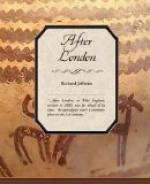In another minute or two the squeaking of the axle ceased, as the waggon reached the storehouses, and he immediately returned to the pillow. Without, and just beneath the window, there ran a road or way, which in part divided the enclosure into two portions; the dwelling-house and its offices being on one side, the granaries and storehouses on the other. But a few yards to the left of his room, a strong gate in the enclosing wall gave entrance to this roadway. It was called the Maple Gate, because a small maple tree grew near outside. The wall, which surrounded the whole place at a distance of eight or ten yards from the buildings, was of brick, and about nine feet high, with a ditch without.
It was partly embattled, and partly loopholed, and a banquette of earth rammed hard ran all round inside, so that the defenders might discharge darts or arrows through the embrasures, and step down out of sight to prepare a fresh supply. At each corner there was a large platform, where a considerable number of men could stand and command the approaches; there were, however, no bastions or flanking towers. On the roof of the dwelling-house a similar platform had been prepared, protected by a parapet; from which height the entire enclosure could be overlooked.
Another platform, though at a less height, was on the roof of the retainers’ lodgings, so placed as especially to command the second gate. Entering by the Maple Gate, the dwelling-house was on the right hand, and the granaries and general storehouses on the left, the latter built on three sides of a square. Farther on, on the same side, were the stables, and near them the forge and workshops. Beyond these, again, were the lodgings of the retainers and labourers, near which, in the corner, was the South Gate, from which the South Road led to the cattle-pens and farms, and out to the south.
Upon the right hand, after the dwelling-house, and connected with it, came the steward’s stores, where the iron tools and similar valuable articles of metal were kept. Then, after a covered passage-way, the kitchen and general hall, under one roof with the house. The house fronted in the opposite direction to the roadway; there was a narrow green lawn between it and the enceinte, or wall, and before the general hall and kitchens a gravelled court. This was parted from the lawn by palings, so that the house folk enjoyed privacy, and yet were close to their servitors. The place was called the Old House, for it dated back to the time of the ancients, and the Aquilas were proud of the simple designation of their fortified residence.
Felix’s window was almost exactly opposite the entrance to the storehouse or granary yard, so that the waggon, after passing it, had to go but a little distance, and then, turning to the left, was drawn up before the doors of the warehouse. This waggon was low, built for the carriage of goods only, of hewn plank scarcely smooth, and the wheels were solid; cut, in fact, from the butt of an elm tree. Unless continually greased the squeaking of such wheels is terrible, and the carters frequently forgot their grease-horns.




